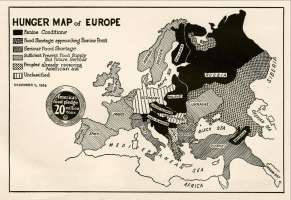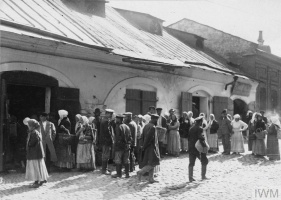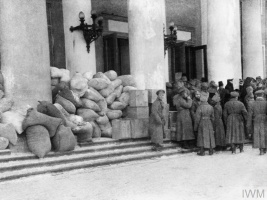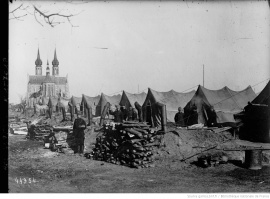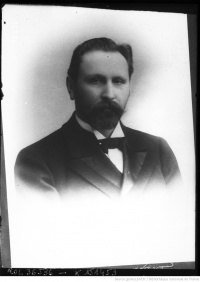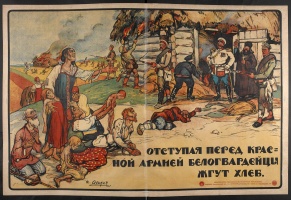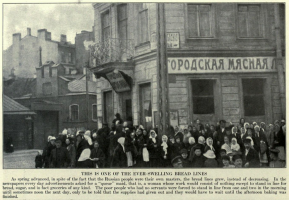Agrarian production and food consumption during the war↑
On the eve of the First World War, the most notable fear concerned with food supply was the fear of overproduction. The war with Germany, Austria-Hungary and Turkey should have strictly limited or even stopped the export of Russian grain and other foodstuffs. Thus, the government and businessmen hoped for a fall in prices and did not initially worry about army provision or food supply for cities.[1] Unfortunately, before 1914, strategists had not taken into account the deep impact of war on economics.
The first and most essential problem was total mobilization, which became a disaster for food production. According to modern calculations, the potential number of conscripts was about 16 million after all exceptions.[2] Indeed, the total number of draftees by the end of 1917 was about 15.5 million.[3] Most of these (84-88 percent)[4] were peasants, and their withdrawal from their usual work routine caused serious troubles in farm life. But there was also another problem. Soldiers went from being a productive group within society to being a group of consumers. A journalist from a co-operative magazine remarked that “millions of sons of rustic Russia were malnourished in peacetime, but now they require normal soldiers' portions.”[5] The food supply of the army during the war (see Table 1) constantly grew and allowed for the establishment of high rations.
| Type of products | 1914 | 1915 | 1916 | 1917 |
| Wheat | 387.04 | 1,940.12 | 3,476.8 | 3,690 |
| Groats | 55.76 | 250.92 | 574 | 492 |
| Oats and barley | 862.64 | 2,519.04 | 4,838 | 2,870 |
| Meat | 221.4 | 326.4 | 1,344.8 | 1,279.2 |
Table 1: Army supply in 1914-1917 (in million kilogram)[6]
The high level of army food supply was accompanied by serious hardships on the home front. The decrease in land available for cultivation (see Table 2) was considered the biggest problem, but there was no way to persuade peasants and landowners to keep or enlarge ploughed land. The causes of this decrease were, of course, the mobilization of farm labourers as well as growing wages for other workers. At the same time, there were serious shortages of fertilizers and agricultural equipment. Many households were also cruelly hit by the mobilization of plough horses.[7]
| Type of products | 1914 | 1915 | 1916 | 1917 |
| Food crop | 58.71 | 57.342 | 51.738 | 52.404 |
| Feed crop | 27.002 | 25.049 | 24.173 | 23.443 |
Table 2: Changes in cultivated area in Russia in 1914–1917 (millions of desiatins, one desiatina is approximately equal to one hectare)[8]
| Type of products | 1914 | 1915 | 1916 | 1917 |
| Food crop | 52,135 | 55,022 | 43,460 | 41,885 |
| Feed crop | 24,436 | 23,862 | 21,599 | 20,451 |
Table 3: Changes in croppage in Russia in 1914–1917 (millions kg)[9]
During the war, peasants turned to the autarkical form of animal husbandry because of political, economic and social uncertainty (inflation, scarcity of food and consumer goods, waves of refugees, transportation chaos etc.). Peasant women who remained at home tended to preserve stored grain and money until their husbands and sons came back. According to historians, the median level of peasant nutrition appears to have stayed normal.[10]
In fact, each year of the war (except plentiful 1916, see Table 3), the croppage became worse than the previous year. While the army supply grew bigger, the food supply of cities and towns declined: “in 1909–1913 around 12.4 per cent of all grain and fodder crops reached the market, by 1915 this had fallen to 7.4. per cent”.[11] This obstacle made city residents plan food procurement using non-economic methods, such as army requisitions, fixed prices and prohibition of trade particularly during times of revolution and the civil war (mostly known in the form of Bolshevik “prodrazvyorstka”).
Indeed, the situation in urban areas was more complicated than in the countryside. Residents in various cities and towns experienced an undoubted decrease in living standards.[12] Increases in salaries (e.g. among industrial workers) were accompanied by increases in prices. The most widespread explanation for this phenomenon was speculation. The peculiarity of this situation was expressed by Sergei Nikolaevich Prokopovich (1871-1955), a Minister of Food Supply in the Provisional Government, who said that retail activity was not the main reason for such a strong rise in prices because retailers “speculated earlier and they are speculating now, although there were no high prices earlier but now there are.”[13]
The consequence of high pricing was customers turning to fake foodstuffs and food surrogates (e.g. butter with lard, diluted and dyed milk, sausages made of starch and waste meat etc.).[14] Such products were cheaper but more dangerous for customers. The elements of fake products tended to be more and more coarse (e.g. lard in fake butter was replaced with different chemicals and industrial food waste) as war and revolution continued.
The spread of profiteering in cities, towns and villages was concurrent with the storing and keeping of products by all households so it was very hard to determine who the profiteers were among the surviving city-dwellers and peasants. In the first two years of war, sugar, meat, butter, colonial goods and bread were highest in demand. The decline of the traditional market strengthened city-dwellers’ confidence in non-economical methods of supply. Profiteers resembled the enemy. Even in 1915, journalist and writer Mikhail Mikhailovich Prishvin (1873-1954) remarked in his diary that “native Germans were [seen] at the front in the beginning [of the war], later among the people with German names, and, finally, among merchants…”[15]
The revolution had harsh effects on food supply and nutrition. The autarkical tendency in the countryside became much stronger because peasants did not want to share their reserves of grain with anybody because of the political chaos. Inflation and the disappearance of some consumer goods made peasants stop trading in cities and towns. Starvation became a reality in 1917. Many people from consuming areas decided to migrate to producing areas. This migration occurred in two directions: from cities and towns to the countryside within one region, and from one region to another. This wave of migrants mixed with refugees from frontline zones and people who escaped from the capital cities, Saint Petersburg and Moscow, because of revolutionary unrest. The huge grain reserves in the countryside were converted to various kinds of moonshine (samogon). This moonshine became the “stable currency” of revolutionary times. The tsarist government had prohibited the free sale of alcohol since the August of 1914 and its fall in 1917 opened the gate of “delirium” for all classes.
Some contemporary historians share the opinion that the tsarist “dry law” indirectly contributed to the rise of inflation and the food supply problem. “A peasant who wanted to drink had no choice but to sell his meagre surpluses of grain, which, in turn, went to the population of cities. Thus, the "dry law" widened the gap between town and country”[16]. The grain which was sold to city merchants before the war now remained in the countryside and Russian “cities suffered because of a shortage of bread. Destroying the hateful state monopoly, Nicholas II destroyed the economic mechanism that protected the empire from collapse.”[17]
The official food supply system↑
Central power and the problem of army supply↑
Mobilization in 1914 demanded great effort in purchasing, storing and transporting thousands of wagons with food to the fronts on the western and southern frontiers of Russia. During the war, the 105 commissaries directly supplied the armies.[18] A special department (“Khlebarmia”) within the General Administration of Land Use and Agriculture was created for the coordination of purchasing operations on the home front.[19] “Khlebarmia” was not intended to supply civilians and bought only grain and flour. The twin-department stored up other provisions and forage. Governors, heads of gubernia zemstvo and occasionally heads of local corn exchanges were appointed as agents of these departments.
Because of increases in foodstuff scarcity (primarily due to the activity of “Khlebarmia” agents), new state commissions were established in 1915. The most important among them was the Special Council on the Food Supply under the command of the general administrator of land use and agriculture.[20] This Special Council was formed in August 1915 as a part of the great reformation of the whole system of military economics. The stockpiling agents of the Special Council were local officials sometimes already involved in “Khlebarmia” purchasing campaigns. The Special Council distributed financial credits among cities and countryside areas for buying food. This system was kept in place until the 1917 February Revolution. Just before the revolution began, Aleksandr Aleksandrovich Rittikh (1868-1930), the new Minister of Agriculture, proposed a grain levy system (also known as Rittikh’s prodrazvyorstka) to stimulate grain purchasing. However, as most historians had predicted, it was unsuccessful.[21]
All these obstacles within the food procurement system were accompanied by aggressive political manoeuvrings. At the end of 1916, conflicts between zemstvos and the government reached their peak. The Minister of Internal Affairs, Alexander Dmitryevich Protopopov (1866-1918), a protégé of Alexandra, Empress, consort of Nicholas II, Emperor of Russia (1872-1918) and the notorious Grigori Rasputin (1869-1916), tried to seize control over price regulations in the provinces. “The final documents placing full responsibility over the food supply in Protopopov’s ministry were completed on October 30 and sent to the tsar.”[22] The tsar and Prime Minister Boris Vladimirovich Stürmer (1848-1917), tried to issue a law bypassing the State Duma. “Everything was now set, but at the last moment the plan was abandoned for fear of unrest.”[23]
After the February Revolution in 1917, the new Provisional Government tried to preserve the old system of purchase via “Khlebarmia” and also extended the coordination of civilian procurement by creating the Ministry of Food Supply. This organization tried to control various local agencies which were formed by self-governmental bodies after the collapse of the ancient regime. The commissars of the Provisional Government which replaced tsarist governors were incapable of dealing with them. The most important activity of the Provisional Government in the field of food procurement, the so-called “the Grain Monopoly”, in which the state bought at a fixed price, was completely unsuccessful.[24] Owing to this failure, state officials used armed requisitions in five gubernyas apart from the frontline zone where it was a common phenomenon during the war. Peasant riots in the countryside ensued.[25]
The efforts of provincial powers↑
The supply system of Russian cities, towns and villages was carried by local authorities (governors and their administration especially) and self-government bodies (dumas in cities and zemstvos in the countryside). Governors had the power to control prices by fixing them and punish profiteers. The most important force used by governors was the police. However, Russian citizens doubted the ability of the police to cope with the black market and speculation. Governors usually preferred to control and stimulate self-government bodies to procure essential food which could be distributed via private shops or municipal stores.
In cities, city council members and traders or producers of a particular product (flour, baked bread, sugar, oil, salt, etc.) held regular meetings. At these meetings, arrangements about prices were made. However, market prices grew rapidly and the free market evolved into a black market which city officials preferred to ignore. Nevertheless, regulations and rationing could not be avoided.
In 1916, Russian city dumas established a rationing system based on the census, food quantities and a special ration card system. Until that time for many officials, this system operating in Western Europe was only “a German invention, unfit for resolving the food crisis in Russian conditions”.[26] At the same time, dumas and zemstvos supported the systems of municipal shops and special contracts (the latter allowed the dumas to use the railways over-trafficked during the war).
After February 1917, city authorities were caught up in the general political chaos and the collapse of traditional power structures. Under these conditions, they attempted to depend on the achievements of co-operatives in the food supply of a population, but it turned out to be unsuccessful because of peasant self-sufficiency and collapse of railways. The cities went further along the path of a rigid food policy, demanding total requisition of grain and other food in the countryside.
Problems of civilian “self-supply”↑
Consumers’ co-operatives↑
State officials had two options for solving the food crisis during the war. The most conventional option was relying on merchants who had organizational experience, great mobilization opportunities and a huge amount of capital. However, their opposition to the government was too obvious and they were unpopular among the people because they were suspected of speculation.[27]
Politically-motivated co-operatives were novel, popular and showed no signs of “profiteering”. The war had an extraordinary impact on the co-operative movement in Russia (e.g. Samara gubernya had 208 co-operatives in 1914 and 608 in 1917).[28] First of all, co-operatives helped to fight against high prices. “It is a fact,” the Simbirsk zemstvo newspaper noted, “that the consumer society which arose in the villages was a threat to the brave merchants and restrained their immoderate, greedy appetites.”[29] Secondly, they also supplied the army with food and forage. Co-operative activities included credit partnerships in the countryside. In addition, the co-operatives took care of the families of the soldiers and helped the refugees.
The growth of consumer co-operation during the war happened because of a change in the attitude of the authorities. Because of the critical shortage of most essential products, it became possible to establish a system of regular distribution of goods among the population in rural and urban areas via consumers’ co-operatives. The system of co-operatives protected from a monopoly of private traders made it possible to do without an inflated bureaucratic apparatus of distribution. Also, such growth was possible thanks to the support of new companies by existing credit co-operatives. The latter acted as creditors, lending the necessary funds for the purchase of products. Members of credit organizations were frequently also the heads of a consumers’ society.
Food riots↑
Food riots began in 1915 because people were discontent with high prices and food scarcity. These riots typically took place at city markets when one (or more) merchant was accused of overpricing or selling surrogate or unsound food. The quarrels between merchant and customers were often followed by fights and the looting of some shops and stores. Sometimes the police and army were involved and crowds of people were fired upon, causing casualties. Participants in food riots used political slogans with anti-war and anti-governmental appeals. These riots increased during the period just before the February Revolution.
In 1915, there were almost twenty such incidents. In 1916, this figure rose to 288. In 1917, it was difficult to come up with accurate estimations of the number of riots because of the general chaos affecting the police and newly established militia. The increase in incidents before 1917 happened because of peasant food riots.[30] The main cause of quarrels in 1915–1916 was the rise in the price of sugar. In 1917, however, there was an absolute scarcity of all products. The riots in 1917 were unstoppable. Police abandoned their duties and soldiers became riot participants, calling them requisitions or official food searches.
“Bag men”↑
In 1917, urban and rural inhabitants began setting up small groups for “self-supply” that were called “meshochnichestvo” (“bag men”, because they took bags — Russian “meshok” - with them as they travelled around looking for food).[31] Self-supply was divided into two parallel processes. The inhabitants of consuming regions went to producing regions while city dwellers infiltrated villages in search of food. In 1917, “bag men” bought products in the countryside using cash in most cases but because of rapid inflation, barter became the general form of trade.
The result of meshochnichestvo was incredible. For example, in the last months of 1917, “bag men” (also known as khodoki, i.e. those who walk, the travellers) imported almost 49 million kilograms of food in Kaluga gubernya while at the same time officials brought only 19 million kilograms.[32] The rise in bag men occurred in 1918 when the state system of procurement was paralyzed by the Civil War. In 1917, they competed with official bodies of procurement and consumers’ co-operatives.
Conclusion↑
The problem of food and nutrition superseded all other problems in wartime Russia. Business as usual was impossible because none of the participants in the market system (producers, distributors and consumers) could come to a compromise. Speculation (and, more importantly, the government’s failure to cope with it) undermined peoples’ belief in the state and made them look for a better way of organization. The success of the self-supply system demonstrated the irrelevance of the old state and became the cause of revolution.
Iaroslav Golubinov, Samara State Medical University
Section Editors: Boris Kolonit͡skiĭ; Nikolaus Katzer
Notes
- ↑ Anfimov, A.M.: Rossiyskaya derevnya v gody pervoy mirovoy voyny (1914 — fevral' 1917 g.) [The Russian countryside during the First World War (1914-February 1917)], Moscow 1962, p. 276-278; Prokopovich, S.N.: Voyna i narodnoye khozyaystvo [War and the National Economy], Moscow 1917, pp. 11, 16, 25.
- ↑ Astashov, A.: Russkiy front v 1914 — nachale 1917: voyennyy opyt i sovremennost' [The Russian Front in 1914 — beginning of 1917: Military experience and contemporaneity], Moscow 2014, p. 19.
- ↑ Ibid., p. 33.
- ↑ Ibid., p. 29.
- ↑ Izvestiya Samarskogo obshchestva “Samopomoshch” [Bulletin of Samara (cooperative) society ““Samopomoshch”], Samara 1916, No. 3, p.4.
- ↑ Astashov, Russkiy front v 1914 [The Russian Front in 1914] 2014, p. 280.
- ↑ Sidorov, A. L.: Economicheskoe polozhenie Rossii v gody pervoi mirovoj vojny [The economical situation in Russia during the First World War], Moscow 1973, p. 461.
- ↑ Kitanina, T. M.: Vojna, khleb i revolyutsiya: prodovol'stvennyj vopros v Rossii, 1914 — Oktyabr' 1917 g. [War, bread and revolution: The food problem in Russia, 1914 — October 1917], Leningrad 1985, p. 21.
- ↑ Ibid., p. 25.
- ↑ Binshtok, V.I./Kaminskii, L.S.: Narodnoe pitanie i narodnoe zdravie [People's nutrition and health], Moscow 1929, pp. 34–35.
- ↑ Gatrell, Peter: Russia's First World War. A social and economic history, Harlow 2005, p. 171.
- ↑ Aksenov, V.B.: Povsednevnaya zhizn' Petrograda i Moskvy v 1917 godu [Everyday life of Petrograd and Moscow in 1917]. Dissertation thesis, Moscow 2002.
- ↑ Prokopovich, Voyna i narodnoe khozyastvo [War and the National Economy], p. 129.
- ↑ Tverdyukova, Ye. D.: “Kolbasa delo doveriya”: fal'sifikatsiya pishchevykh produktov v Rossii v gody Pervoy mirovoy voyny (1914-1918 gg. ) [“Sausage is a matter of confidence”: The falsification of food in Russia during the First World War (1914-1918)], in: Noveyshaya istoriya Rossii [Modern History of Russia] (12) (2015), pp. 71–81.
- ↑ Prishvin, M.M.: Dnevniki. 1914–1917 [The Diaries of 1914-1917], Мoscow 2007, p. 211.
- ↑ Mak-Ki, A.: Sukhoy zakon v gody Pervoy mirovoy voyny: prichiny, kontseptsiya i posledstviya vvedeniya sukhogo zakona v Rossii: 1914–1917 gg. [The Dry Law during the First World War: Its causes, conception and consequences in Russia: 1914-1917], in Smirnov, N. N. (ed.): Rossiia i Pervaia mirovaia voina. Materialy mezhdunarodnogo nauchnogo kollokviuma [Russia and the First World War. Materials of an international colloquium], St. Petersburg 1999, p. 155.
- ↑ Ibid.; Also see: Shcherbinin, P.P.: Alkogol' v povsednevnoy zhizni rossiyskoy provintsii v period Pervoy mirovoy voyny 1914 - 1918 godov [Alcohol in everyday life of Russian provinces during the First World War], in Magistra Vitae: elektronnyy zhurnal po istoricheskim naukam i arkheologii [Magistra Vitae: Electronic Journal of History and Archeology] 2/16 (2003), p. 70.
- ↑ Aranovich, A.V.: Sistema prodovol'stvennogo dovol'stviya voysk nakanune i v gody Pervoy mirovoy voyny [The System of army alimentation on the eve of the First World War], in Vestnik molodykh uchenykh [Bulletin of Young Researcher] 1 (2005), p. 22.
- ↑ Kondratiev, N. D.: Rynok khlebov i ego regulirovanie vo vremia voiny i revoliutsii [The Wheat market and its regulation during the war and revolution], Moscow 1991, p. 167.
- ↑ Eroshkin N. P./Raskin, D.I. (eds.): Vysshiye i tsentral'nyye gosudarstvennyye uchrezhdeniya Rossii. 1801-1917 gg. [The Highest and Central State Bodies of Russia 1801- 1917], St. Petersburg 1998, Vol. 1., pp. 216-219.
- ↑ This was a widespread idea among Soviet historians. See Kitanina, Vojna, khleb i revolyutsiya: prodovol'stvennyj vopros v Rossii [War, bread and revolution: food problem in Russian] 1985, p. 262 and passim. However, an alternative version appeared in the 1990s. See Matsuzato, Kimitaka: Prodrazverstka Rittikha [Rittikh’s Grain Levy], in: Acta Slavica Iaponica, Sapporo 13 (1995), pp. 167-183.
- ↑ Fallows, Thomas: Politics and the war effort in Russia: The Union of Zemstvos and the Organization of the food supply, 1914-1916, in: Slavic Review 37/1 (1978), p. 85.
- ↑ Ibid.
- ↑ Kitaniana, Vojna, khleb i revolyutsiya: prodovol'stvennyj vopros v Rossii [War, bread and revolution: the food problem in Russia] 1985, p. 302 and passim.
- ↑ Volobuyev, P. V.: Ekonomicheskaya politika vremennogo pravitel'stva [Economic politics of the Provisional Government], Moscow 1962, p. 454 and passim.
- ↑ Kartochnaya sistema v gorodakh [Rationing cards system in cities], Moscow 1916, p. 2.
- ↑ For more details on bourgeois opposition to the tsarist regime see Dyakin, V.S.: Russkaya burzhuaziya i tsarizm v gody Pervoj mirovoj vojny (1914-1917) [The Russian bourgeoisie and tsarism during the First World War 1914-1917], Leningrad 1967.
- ↑ Tseloval'nikova, I.I.: Dinamika razvitiya potrebitel'skoy kooperatsii v Srednem Povolzh'ye v 1906-1917 godakh [The progress of development of consumers’ cooperation movement in Middle Volga 1906-1917], in: Krest'yanin v miru i na voyne: Materialy III Merkushkinskikh chteniy [Peasantry in time of peace and war: Proceedings of the 3rd Merkushkin Conference], Saransk 2005, p. 395.
- ↑ Simbirskij khozyain [Simbirsk Farmer], Simbirsk No. 1 (1916), pp. 32-37.
- ↑ Kiryanov, Yu.I.: Social'no-politicheskij protest rabochikh Rossii v gody Pervoj mirovoj vojny (iyul' 1914 — fevral' 1917 gg.) [Social and political protest of Russian workers during the First World War, July 1914 – February 1917], Moscow 2005, p. 139.
- ↑ Davydov A. Yu.: Meshochniki i diktatura v Rossii. 1917-1921 [Bag men and dictatorship in Russia 1917-1921], Saint Petersburg 2007.
- ↑ Ibid., pp. 45–46.
Selected Bibliography
- Alpern Engel, Barbara: Not by bread alone. Subsistence riots in Russia during World War I, in: The Journal of Modern History 69/4, 1997, pp. 696-721, doi:10.1086/245591.
- Anfimov, Andrei Matveevich: Rossijskaya derevnya v gody Pervoi mirovoi voiny (1914-Fevral’ 1917) (Russian countryside during the First World War (1914-February 1917)), Moscow 1962: Sotsekgiz.
- Binshtok, V. I. / Kaminskii, L. S.: Narodnoe pitanie i narodnoe zdravie v voinu 1914-1918 gg. (People's nutrition and people's health in the war of 1914-1918), Moscow 1929: Gosizdat, Otdel voennoi literatury.
- Bukshpan, Ya. M.: Voenno-khoziaistvennaia politika. Formy i organy regulirovaniia narodnogo khoziaistva za vremia mirovoi voiny 1914-1918 gg. (Politics of the military economy. Shapes and regulators of the people's economy during the world war 1914-1918), Moscow 1929: Gosudarstvennoe izdatel’stvo.
- Davydov, A. Yu.: Meshochniki i diktatura v Rossii, 1917-1921 (Bag men and dictatorship in Russia, 1917-1921), Saint Petersburg 2007: Aleteja.
- Fallows, Thomas: Politics and the war effort in Russia. The union of Zemstvos and the organization of the food supply, 1914-1916, in: Slavic Review 37/1, 1978, pp. 70-90.
- Gatrell, Peter: Russia's First World War. A social and economic history, Harlow 2005: Pearson/Longman.
- Kitanina, T. M.: Voina, khleb i revoliutsiia. Prodovol'stvennyi vopros v Rossii, 1914 - Oktiabr' 1917 g. (War, bread and revolution. Food problems in Russia, 1914 - October 1917), Leningrad 1985: Nauka.
- Kondratiev, N. D.: Rynok khlebov i ego regulirovanie vo vremia voiny i revoliutsii (The wheat market and its regulation during the war and revolution), Moscow 1922: Novaja derevnja.
- Lih, Lars T.: Bread and authority in Russia, 1914-1921, Berkeley 1990: University of California Press.
- Matsuzato, K.: Interregional conflicts and the collapse of Tsarism. The real reason for the food crisis in Russia after the autumn of 1916, in: Schaeffer Conroy, Mary (ed.): Emerging democracy in late Imperial Russia. Case studies on local self-government (the Zemstvos), State Duma elections, the Tsarist government, and the State Council before and during World War I, Niwot 1998: University Press of Colorado, pp. 243-300.
- Petrov, Yu. A. (ed.): Rossiya v gody Pervoj mirovoj vojny. Ehkonomicheskoe polozhenie, social'nye processy, politicheskij krizis (Russia in the years of the First World War. Economical situation, social processes, political crisis), Moscow 2014: Rosspen.
- Sidorov, Arkadii Lavrovich: Ėkonomicheskoe polozhenie Rossii v gody pervoi mirovoi voiny (The economy of Russia in the years of the First World War), Moscow 1973: Nauka.
- Sidorov, Arkadii Lavrovich (ed.): Ėkonomicheskoe polozhenie Rossii nakanune Velikoi Oktiabr'skoi sotsialisticheskoi revoliutsii (The Russian economic situation during the Great October Socialist Revolution), 3 volumes, Leningrad 1957-1967: Izdatelstvo Akademii Nauk.
- Smirnov, Nikolaj N. / Galili, Ziva / Kolonit͡skiĭ, Boris et al. (eds.): Rossiia i Pervaia mirovaia voina. Materialy mezhdunarodnogo nauchnogo kollokviuma (Russia and the First World War. Materials of an international colloquium), St. Petersburg 1999: Dmitrii Bulanin and Sankt-Peterburgskii filial Instituta rossiiskoi istorii RAN.
- Struve, Petr Berngardovich (ed.): Food supply in Russia during the world war, New Haven 1930: Yale University Press.





